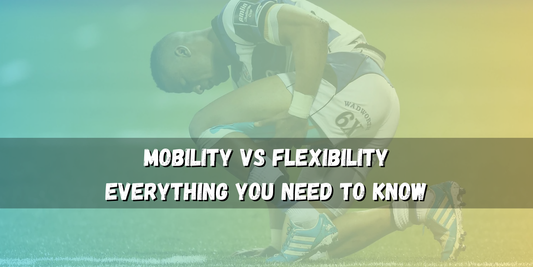Your ankles are involved in nearly every rugby movement—sprinting, cutting, sidestepping, scrummaging, and planting to change direction. Yet for many players, ankle mobility is a forgotten piece of the performance puzzle. Without it, you lose speed, reduce agility, and increase your risk of injury from the ground up.
In Part 2 of our Mobility & Flexibility Series, we’re unlocking one of the most important areas for acceleration, stability, and injury prevention: the ankles.
Check out the rest of the series:
-
Part 1: Hip Mobility – Unlock Power & Stability
- Part 3: Thoracic Mobility – Enhance Movement & Control
- Part 4: Shoulder Mobility – Maximize Range & Strength
- Part 5: Neck Mobility – Absorb Force & Protect Your Spine
- Part 6: Wrist Mobility – Improve Grip & Dexterity
Let’s dive in.
WHAT IS ANKLE MOBILITY?
Ankle mobility is your ability to move your foot freely through its full range of motion—specifically dorsiflexion (bringing your toes toward your shin) and plantar flexion (pointing your toes down).
Unlike flexibility (which is about passive range of motion), mobility is about control, strength, and movement efficiency—key elements for any rugby player.
Good ankle mobility allows you to:
- Accelerate and decelerate efficiently
- Cut and sidestep explosively
- Stay low in scrums and rucks without collapsing
- Absorb impact properly to prevent knee and shin injuries
- Maintain balance and stability under contact
But when ankle mobility is restricted, everything above it compensates—leading to inefficient movement patterns and a higher risk of injuries.
THE ANKLE COMPLEX – YOUR FOUNDATION FOR SPEED & STABILITY
Your ankles are more than just joints—they are the foundation of your movement on the rugby field.
Several key muscles and structures work together to control ankle movement:
1. Calves (Gastrocnemius & Soleus)
- Role: Controls ankle movement and helps with sprinting power.
- When Tight or Weak? Limits dorsiflexion, causing compensations in the knees and hips.
2. Tibialis Anterior (Front of Shin)
- Role: Helps control foot placement and prevents shin splints.
-
When Tight or Weak? Leads to poor foot control, slower reaction time, and increased injury risk.
3. Achilles Tendon
- Role: Absorbs force and transfers energy for explosive movements.
- When Tight or Weak? Reduces power output and increases the risk of Achilles tendinitis.
4. Peroneals (Side of the Ankle)
- Role: Provides lateral stability, preventing ankle sprains.
- When Tight or Weak? Increases chance of rolling your ankle.
5. Plantar Fascia (Bottom of the Foot)
- Role: Supports foot mechanics and shock absorption.
- When Tight or Weak? Can cause foot pain, poor foot positioning, and reduced speed.
Since your ankles connect your feet to the rest of your body, any restriction affects your entire kinetic chain—from your knees to your lower back.

WHY ANKLE MOBILITY IS A MUST FOR RUGBY PERFORMANCE
1. Faster Acceleration & Deceleration
Explosive speed starts from the ground up. If your ankles move freely, you maximize your push-off power and reaction time—helping you beat defenders in a foot race.
2. Better Agility & Direction Changes
Sidestepping, stepping into a tackle, and evading defenders require full ankle dorsiflexion. Tight ankles limit your ability to cut sharply, making your movements slower and less controlled.
3. Stronger & Safer Scrummaging & Rucking
Forwards need deep ankle mobility to stay low and drive forward in scrums and rucks. If your ankles are tight, you’ll struggle to get into position—causing lower back or knee strain.
4. Lower Risk of Injury (Ankle, Knee, Shin, & Achilles Injuries)
Restricted ankle mobility forces your knees and hips to compensate, increasing the risk of:
- Ankle Sprains
- Shin Splints
- Patellar Tendinitis (Knee Pain)
- Achilles Tendonitis
THE CHAIN REACTION: HOW POOR ANKLE MOBILITY CAUSES INJURIES
Your body moves in a kinetic chain—when one joint isn’t moving properly, another joint takes the load.
Here’s how tight ankles lead to injury:
- Limited Ankle Mobility → Knees Collapse Inward → ACL or Meniscus Injuries
- Stiff Achilles → Overworked Knees → Patellar Tendinitis
- Restricted Dorsiflexion → Poor Shock Absorption → Shin Splints
Many young rugby players already struggle with ankle mobility due to sitting too much (school, video games) and wearing stiff shoes.
If left unaddressed, these issues lead to chronic pain and frequent injuries.
THE ANKLE MOBILITY ROUTINE EVERY RUGBY PLAYERS NEEDS
You can unlock your ankle mobility in just 10-15 minutes a day.
This three-step process combines foam rolling, stretching and strengthening to free up your ankles and improve movement.
Step 1: Foam Rolling (3-5 Minutes)
- Goal: Loosen up tight muscles and increase blood flow.
- Muscles: Calves, Soleus (Lower Calf), Tibialis Anterior (Shin), Foot / Plantar Fascial
Step 2: Stretching & Mobility Drills (5-10 Minutes)
- Goal: Unlock ankle dorsiflexion and plantar flexion for better movement.
- Exercises: Dorsiflexion Stretch, Calf Stretch, Banded Ankle Mobilization, Heel and Toe Walk.
Step 3: Make It a Daily Habit
Ankle mobility work is not optional—it’s part of rugby preparation.
- Before Training: Use mobility drills as part of your warm-up.
- After Training: Stretch & foam roll to prevent stiffness.
- On Rest Days: Do extra work on tight areas.
WATCH THE FULL ROUTINE
We’ve put together the full routine on our YouTube channel to guide you through these foam rolling, stretching and activation exercises.
Check the Hip Mobility Routine below:
FINAL THOUGHTS
Improving ankle mobility doesn’t just help you move better—it builds the foundation for explosive speed, sharp direction changes, and a lower injury risk.
- Faster acceleration and change of direction
- Decreased risk of shin splints, sprains, and knee pain
- Better balance and movement control under pressure
Start today. Your ankles (and your performance) will thank you.
Need More Help?
Check out our Rugby Workout Plans and Customized Training Programs to build a stronger, more resilient body.
This wraps up Part 2 of our Mobility & Flexibility Series: Ankle Mobility. If you found this post helpful, make sure to:
- Like and share this post with fellow rugby players
- Bookmark the blog to stay updated on the next parts of the series
-
Follow Peak Rugby on X, Facebook and subscribe to the YouTube Channel for more rugby-specific training, mobility, and recovery tips.
Stay strong, keep pushing forward, and keep working on your mobility!















